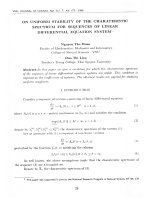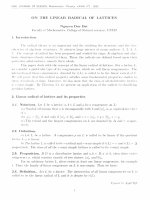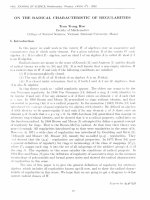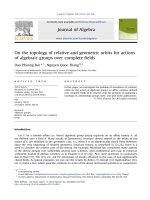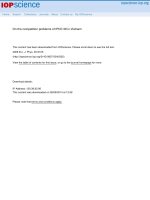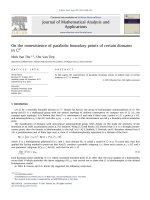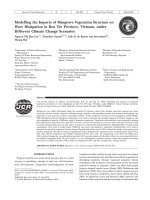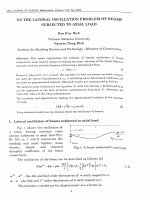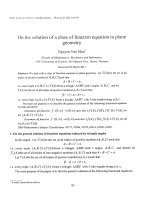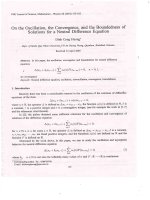DSpace at VNU: On the amplifiction of sound (acoustic phonons) by absorption of laser radiation in cylindrical quantum wires with parabolic potential in the presence of magnetic field
Bạn đang xem bản rút gọn của tài liệu. Xem và tải ngay bản đầy đủ của tài liệu tại đây (2.38 MB, 7 trang )
VNU. JOURNAL OF SCIENCE. M athem atics - Physics. T .X V III, N()3 - 2002
O N T H E A M P L IF IC A T IO N
OF SO U N D
(A C O U S T IC
P H O N O N S ) B Y A B S O R P T IO N O F L A S E R R A D IA T IO N
C Y L IN D R IC A L Q U A N T U M W IR E S W IT H
IN
P A R A B O L IC
P O T E N T IA L IN T H E P R E S E N C E O F M A G N E T IC F IE L D
N guyen Q uoc H ung an d N guyen Q uang B au
D e p a rtm e n t o f P hysics, C ollege o f S c ien c e - V N U
A b s tr a c t Based on the quantum kinetic equation for phonon, the amplification
of sound (acoustic phonons) due to the absorption of laser radiation in cylindrical
quantum wires w ith parabolic potential in the presence of m agnetic field is studied.
Analytical expressions for the rate of acoustic phonons excitations, the conditions for
the amplification of sound and the m om entum conditions for electron to participate
in the amplification of sound are obtained for the two cases: singlephoton absorption
process and m ultiphoton absorption process. T he differences betw een the two cases
of singlephoton absorption and m ultiphoton absorption are discussed; the numerical
com putations and plots are carried out for a G aA s/G aA sA l quantum wire. The
results are compared w ith bulk sem iconductors and quantum wells.
1. I n tr o d u c tio n
It is well known th a t the interaction of a. laser radiation w ith m aterials can lead to
the excitations of higher harm onics arid the am plification of phonons. T he problem has
been widely investigated in the past in a num ber of papers [1-6]. In [1-3] the problem has
been studied in bulk semiconductors with singlephoton absorption process and m ultipho
ton absorption process for degenerate and non-degenerate electron system . In [4,5] the
problem has been considered for quantum wells w ith singlephoton absorption process and
m ultiphoton absorption process and in the presence of ưiagnetic field. All these authors
shown th at the phonon population grows w ith tim e under some conditions.
In tills paper, we study the influence of m agnetic field on the amplification of sound
(acoustic phonons) due to the absorption of laser radiation in cylindrical quantum wires
w ith asym m etric parabolic potential. Based on the quantum kinetic equation for phonon,
we obtain analytical expressions for the rate of change of the population of the phonon
states, the conditions for the amplification of sound, and m om entum condit ions for electron
to participate in the amplification of sound w ith the presence of m agnetic field in th e two
cases: singlephoton absorption process and m ultiphoton absorption process. All results
are numerically com puted and plotted for a G aA s/G aA sA l quantum wire.
2. R a te s o f a c o u s tic p h o n o n s e x c ita tio n
Consider a quantum wire with elliptical cross section and asym m etric parabolic
confining potential:
T y p e s e t by .ẠẠ/IìS-T^X
10
O n th e a m p lific a tio n o f s o u n d (a c o u s tic p h o n o n s ) by.
11
V { x , y ) = % - { t f x x 2 + t f y y 2).
Here f2Z)f1y are the effective frequencies of the potential and 771* is the effective
electron inass.
Assume the vector potential p of the titled magnetic field B in the form p =
(0, B z x } B x y —B yx ) ) electron wave function and energy can by w ritten as [7Ị:
$
n’
eikz
-7>(x,y,z) — —= — ■
1
/ x \
...— c 71X H n ( y- I
ự l y/2*nllxy/ĩỉ
-= =
1
V J y/2‘lllyự ĩ
h2k 2
£n, i(kz ) = — ~~ 4- ^ 1 ( n + 1/2) + àiL>2 (/ 4- 1 /2 ),
(2)
where M = m*
1+ t e ) + t e )
1
~
l' - \ J W Û 7 ’ 1 “
Wc - ^
is
the cyclotron frequency, I I n ( x) is H erm itte polynomial of order n, L is the length of the
wire,
i
m + fiỉ +
wi
+ 2 ù , n J 1+ ( ^ ) 2+ ( ^ )
i/2
íìỈ +
+ 0,2 - 2 Í 2
\
W ith bulk phonon assum ption, the H am iltonian for the electron-phonon system of
a quantum wire in the external field can be w ritten as:
# ( 0 = X ] £" 'i ( k ~
n,i,1c
+
(3)
where a
and a /
(fci. and ò-ỹ ) are the creation and annihilation operators of
pẮc
^I ®
■
electron (phonon); /c = ( 0 , 0 , k z ) is the electron wave vector (along the wire’s axis: zaxis);
is the phonon wave vector; ~Ầ(t) = fịE o c o s (íìt) is the potential vector, depends on
the laser radiation; Cn I n#l’C
deformation acoustic potential, f) is the density of the m aterial, v s is the sound velocity in
the m aterial, R is the wire’s radius, I n i n ’ I’ is the form factor.
Prom Ham iltonian (3), we obtain the quantum kinetic equation for acoustic phonons
in quantum wires:
N g u y e n Q uoc H u n g , N g u y e n Q u ang B a u
12
Ĩ2
~ * 2
n.ỉ.n',/'
x ^
^
|C 'n,ỉ,n',i'("ỹ)|2 ^
7?
( n n , ỉ ( ^ ~ ~ t ) - " n '. l '( " ^ ) ) [
(bt ) t i x
•/ -°°
( « î ) ( / ế ì ) e x p ( ^ £ n '’r ^ ^ “ £n- ' ^
~
- 0 -
+ í s í ì í ^ dt
W here the sym bol ( x) t m eans the usual therm odynam ic average of operator x\ n n /( k ) =
(a * ~>a l -j+)ti ^ — ~ ^ i i 2 ) *A/(æ) is the Bessel fonction of the first kind.
Perform Fourier transform ation, from the dispersion equation for phonon, we obtain
th e rate of acoustic phonons excitations:
E
=
oo
x
\C n .l,n > ,l> ( t ) \
2Y
, \ n n ' , l ' ( t ) - n n ,l ( t
/
]C ^
\ \
( « 2 ) ố {ff« ' ( ^ ) - £ n , i ( ~ k
- t ) } x
- ~ỉ) -
- W in } ,
(5)
u = —00
w ith ố(x) is the D irac function.
From (5), we process w ith non-degenerate electron system assum ption to obtain the
rate of acoustic phonons excitations in the case of singlephoton absorption process and
the case of m ultiphoton absorption process.
3. T h e a m p lific a tio n o f s o u n d in t h e c a s e o f s in g le p h o to n a b s o r p tio n p ro c e ss
In the case of singlephoton absorption process, assume th a t A <^c ÍỈ, from (5) we
obtain the ra te of acoustic: phonons excitations in quantum wires:
a { t )
X
=
w
ẩ
9
E
n,/,n\r
K W < * )I* *
e x p l ^ - 0 h u j i ( n + 1/2) + (3huj2{l + 1/2) e ,p
+ ^2^ 2) +
~ ~ 2
~ I x
- 4 ^ ) sh
sh ( n p ^ ± ^ j I exp
(6)
w ith a =
—n l ) —fox/2 (ỉ —I ' ) +
0=
Due to Ổ function in (5), only /c satisfies condition:
kn
is Boltzm ann constant.
O n th e a m p lific a tio n o f s o u n d ( a c o u s tic p h o n o n s ) b y . . .
13
contributing in the integral, or only electrons with m om entum satisfying condition (7) call
dam p or amplify phonons.
From ( 6 ), it is obvious when ÌAỈ-Ệ
Q is negative, we have the amplification of
sound:
m * L \2
V"
,-^ ,2 _
ịr ,
°< *> =
t ] ị
(h ịiu ì-ệ
( . 2
exp
rnmp n '2 \
-
“ V
)
X exp f —(3huJi(n + 1/2) +« /3hüJ2(l + 1/2)
1/ 2> - f ặ ) x
X sh
( huj-Ệ + fiwi(n -—nu')/) ++ ỉĩuJ2{ị - 00 ) ^) ••
sh
(8)
4. T h e a m p lific a tio n o f s o u n d in t h e c a se o f m u ltip h o to n a b s o r p tio n p ro c e s s
Use th e approxim ate form ula as in [8 ]:
fl(A2 - g )
7T\/A2 — Z£2 >
with:
Ớ
if X > 0
ÍI 01,,
if X < 0
From (4), after several calculations, we obtain the rate of acoustic phonons excita
tions in the case of m ultiphoton absorption process:
f
j y \
/ s v \ \
i/=0
with:
X n i ( x ) - e xj){h(3u >x(n + 1/2) + h(3u>2(l + 1/2)) X
X exp ~ 2fi2~2 ( ^ i ( n —n 0 + ^ 2 ^ - I') + X +
(n —n ') 4- hx)2{l — ư) + X + huJ-ệ )
X /„ {^ - Ị ạ - ặ ỌiMx(n - n ') +
/„(x) is the complex Bessel function of the order V.
- 0 + x+
»
N g u yen Quoc H u n g , N g u y en Quang B a u
14
In a similar way to (7), we have the m om entum condition for electron to participate
in the dam ping or am plification of sound:
(10)
Note th a t if:
X n '1 V 2 m* )
X n,'v \ 2 m* ) ’
(11)
then a(~ ỹ ) < 0 , or the num ber of phonon grows w ith time.
5. N u m e ric a l r e s u lts a n d d is c u s s io n
F igure 1. Dependence of the rate of phonons excitations on phonon wave vector in
the case of singlephoton absorption process; R = 5nm , B = 5T, Í2 = 200 T H z
Prom th e obtained results, we plot the dependence of the rate of acoustic phonons
excitations Q on phonon wave vector
(F ig.l), on laser frequency ÍĨ (Fig.2) and on
tem perature T (Fig.3) for the case of the singlephoton absorption process. Param eters for
num erical com putation are m * = 0.067mo; B = 5Te s l a] v s = 40877715” 1. All figures show
th a t the curves have peaks, which illustrate the m axim um of the amplification of sound,
a t q = 4.7106m “ l , ÍÌ = 130T H z , T = 100 K . Com pare these results w ith quantum wires
in the absence of m agnetic field, we realize th at m agnetic field has certain influence on
the am plification of sound. However, the num erical results for bulk semiconductor and
quantum wells are different a t the range of values of q and Q for the amplification to
happen.
N ote th a t (7) and (10) are the conditions for electron to participate in the dam ping
or the am pification of sound in the wire, b u t not the conditions for the amplification to
happen. In the lim iting case when U-Ệ
Í2 (for singlephoton absorption process) and
(11) (for m ultiphoton absorption process), a(~ ỹ ) < 0 and we have the amplification of
sound, or the num ber of phonon increases w ith tim e as a direct result of the presence of
the laser radiation. These form ulae are more com plicated th an the corresponding formulae
in quantum wells [4-6] due to the intricate dependence of the electron wave function and
energy spectrum on H erm itte polynom ial. W ith bulk sem iconductors, because of the
continuance of th e energy spectrum , the dependence has a completely different form [1-3].
O n the am plification o f so u n d (acoustic p h o n o n s) by.
A J A
T
- 1 7
1
K ,
1
/ m
,
R
« 1 r. n m ,
15
F N - r, T
F igure 2. T he am plification of sound as a function of laser frequency in the case of
singlephoton absorption process; T = —100°c, H = 15nm , t í = 5T
. / ■ 10*
l / m ,
u m c g a « iJ O
XH3,
K «li>nm ,
b-îï
T
F igure 3. Dependence of th e rate of phonons excitations on tem p eratu re in the case
of singlephoton absorption process; Í2 = 1307712, R ~ 15nm , q = 4.7106r a - 1 , B = 5T
In the case of m ultiphoton absorption process, the rate of acoustic phonons ex
citations (9) and the m om entum condition (10) intricately depend on the variable (the
exponent and the complex-Bessel function). T he dependence on the complex-Bessel func
tion / 1/( 2 ), z varies with th e intensity of the laser radiation field (A = —
), shows th a t
the amplification of sound depends on the intensity of the radiation field w ith order greater
than two, while the dependence in the case of singlephoton absorption process is of the
order two ( 6 ). W hen condition (11) is satisfied, we also have the am plification of sound.
Compare these formulae w ith the expression in [1-3] we realize th e difference for b o th the
dependence and the m om entim i conditions.
N g u yen Quoc H u n g , N g u y e n Q uang B a u
16
6 . C o n c lu sio n
1.
2.
3.
4.
In the conclusion, we want to emphasize that:
The quantum kinetic equation for phonon in quantum wires in the presence of
magnetic field was established, which has a sim ilar form w ith those in quantum
wells and bulk wsemiconductors.
Analytical expressions and conditions for the am plification coefficient of sound
were obtained in the case of singlephoton absorption and m ultiphoton absorption.
In proper conditions, the rate of acoustic-phonon excitations is negative and the
phonon population grows w ith time.
The numerical com putations and plots are carried out for a G aA s/G aA sA l quantum
wire. Prom the results, it is easy to see th at there are the ranges of value of phonon
wave vector, laser frequency and tem perature a t which the am plification of sound
happens.
Magnetic field has certain influences on the am plification of sound.
A c k n o w le d g e m e n t: This work is perform ed w ith financial su p p o rt from the N ational
Program of Basic Research in N atural Science No 411301.
R e fe re n c e s
1. Nguyen Q uang Bau, Nguyen Vu Nhan, Chhoum m Navy, J o u rn a l o f S cien ce, N a t.S c i.,
15(1999),1
2. E.M .Epstein, R adio in P hysics, 18(1975), 785.
3. E .M .E pstein, Lett. J E P T ; 13(1971),511.
4. Nguyen Q uang Bau, Vu T hanh Tam, Nguyen Vu N han, J. S c ie n c e and Technical
In v e stig a tio n s in A rm y , No 24, 3(1998),38.
5. Nguyen Q uang Bail, Nguyen Vu Nhan, Nguyen M anh Trinh, Proceedings o f IW O M S
’99, Hanoi 1999, 869.
6 . Peiji Zhao, P hys. R ev., B 49(1994), 13589.
7. V.A.Gey 1er, V .A .M a rg u U s ^ ^ ./te v , B 61, 3(2000),1716.
8 . L.Sholiinal, T u n n el effects in sem ic o n d u c to rs a n d a p p lic a tio n s , Moscow, 1974
